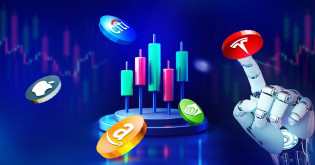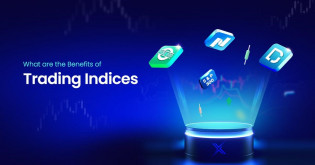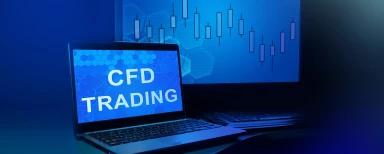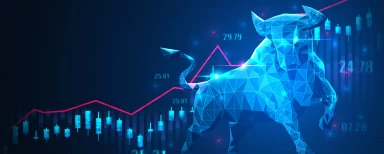Learning about the best indices to trade is highly popular among the traders’ community. The reasons are straightforward: Indices trading allows traders to invest in multiple economies (markets of different countries) through a single platform and they can reap benefits from both bullish and bearish trends. The process of investing is also hassle-free. A beginner just needs to pick suitable indices to enter the market strategically and then make a precise exit to make a profit.
In this guide, we are simplifying the topic of indices trading. Moreover, we will explain the types of indices, some general definitions and how to get started on an indices trading platform, what is the process and why it can be profitable.
Most Common Terms in Index Trading
Indices
‘Indices’ is a plural form of ‘Index’. The performance of stocks, bonds, and other financial instruments in the stock market can be used to estimate the performance of the economy as a whole. Indices are the statistical tools that are used to measure how the economy of a nation is performing.
With these market indices, you can measure how a certain basket of goods has changed over a certain amount of time. For the index to be calculated, a base value and date are chosen, and the change in a basket of securities is figured out.
Contract for difference
A contract for differences (CFD) is an arrangement created in the trading of financial derivatives in which the settlement differences between the open and closing transaction prices are cash-settled. CFDs do not include the delivery of physical goods or securities.
Market index
A market index is a hypothetical portfolio of investment holdings that represents a segment of the financial market. The calculation of the index value comes from the prices of the underlying holdings. Some indexes have values based on market-cap weighting, revenue-weighting, float-weighting, and fundamental-weighting. Weighting is a method of adjusting the individual impact of items in an index.
What are Stock Market Indices?
Indices measure the performance of a cluster of stocks. Indexes allow you to assess a market's overall health and strength rather than just concentrating on the growth or performance of a particular firm, and you have probably heard the media frequently mention them. They may also be referred to as the stock market, share indices, or stock trading indexes.
Indices can represent a single economy of a region Different categories may be used to categorise stock market indices. Stocks from many regions are included in "global" or "world" stock market indices, such as the MSCI World or the S&P Global 100. Regions can be categorised geographically (like in Asia or Europe), economically or in terms of industrialisation (for example, frontier markets, developed markets). Indices are typically divided into three distinct groups: global, regional, and national.
Global Stock Market Indices
The stocks that comprise global stock market indices are issued by companies situated in numerous nations and regions. This gives a number of benefits, the most significant of which is independence from anyone's economic ecosystem. FTSE, S&P, and Dow Jones are examples of this kind of indices. Traders generally pick the best indices to trade from this category.
Regional Stock Market Indices
The regional stock market indices are calculated using groups of stocks that are only traded in certain regions of the world. They can be utilised to gain an understanding of the relative performance of various regions across the globe, such as Asia, Europe, or Latin America, for example.
National Stock Market Indices
National stock market indices, as you might expect, are calculated using a cross-section of companies from a single nation's stock market. They are frequently a reliable indicator of the health of the economy in the country in question. They can also be used to monitor emerging markets, which are countries whose economies are currently on the rise.
Which Indices are Best to Trade?
- Dow Jones Industrials Average (US 30)
- Standard & Poor’s 500 (S&P 500)
- Nasdaq (Composite and Nasdaq 100)
- UK FTSE 100 (FTSE 100)
- CAC 40 (France 40)
- DAX (Germany 30)
- Euro Stoxx 50 (Euro 50)
- Japan 225 (Nikkei 225)
- Hong Kong (Hang Seng Index)
1. Dow Jones Industrials Average (US 30)
Dow Jones Industrial Average is among the oldest indicators in existence (1896). There are thirty components, the majority of which are industrial enterprises, which were formerly a significant sector of the US economy.
In the first part of the 20th century, the Dow was the primary indicator of the US stock market. After World War II, its prominence was eclipsed by the S&P 500 due to the narrowness of its components (only 30 stocks). Despite this, it remains an essential indicator to watch due to its history. Numerous individuals use Dow to describe the success of the US stock market during the past century.
2. Standard & Poor’s 500 (S&P 500)
Standard & Poor's 500 Index ranks first on our ranking (known as S&P 500). It is determined by the market capitalization of the 500 biggest firms listed on the NYSE or NASDAQ. The versatility of this index makes it one of the most actively traded stock indexes. Its motions are broadly observed. Investors believe that the S&P 500 is one of the greatest economic gauges for the United States.
As a result, the S&P 500 can influence the direction of many other global indexes. You may not trade it, but you must comprehend it.
3. Nasdaq (Composite and Nasdaq 100)
The Nasdaq is a growth-oriented stock exchange composed of younger firms seeking to list on a recognised exchange. It is home to trade CFD shares of several tech titans such as Facebook, Amazon, and Google.
The two most prominent indexes comprised of Nasdaq equities are the Nasdaq Composite and the Nasdaq 100. The latter is more volatile due to its fewer constituents. However, volatility is seen positively since it creates additional chances.
4. UK FTSE 100 (FTSE 100)
The Financial Times Stock Exchange 100 Index (FTSE 100) measures the performance of the top 100 firms listed on the London Stock Exchange. The index is market capitalization-weighted, hence it consists of several major, established companies such as Unilever, BP, and HSBC. Due to its representativeness and liquidity, the FTSE 100 is the most popular stock index in the UK.
5. France CAC 40
The CAC (Cotation Assistée en Continu) 40 Index serves as a benchmark for the French stock market. It contains around 40 components, including well-known brands such as LVMH and AXA. Due to the worldwide character of its component firms, a significant portion of the index's earnings come from countries other than France, which explains its popularity among foreign investors. Forbes said that LVMH's owner, Bernard Arnault, is the second richest person in the world, with a net worth of more than $100 billion.
6. Germany DAX
The Deutscher Aktienindex or DAX is a German stock market index. It draws its value from 30 main equities traded on the Frankfurt Stock Exchange and is regarded as a leading economic indicator for Germany. Due to its limited number of components, the DAX index can be more volatile than the FTSE 100 or S&P 500. This index is rather young. It began in 1987.
7. Euro Stoxx 50 (Euro 50)
By market capitalization, the EURO STOXX 50 stock market index is made up of 50 of the largest blue-chip European companies that are still doing business in the Eurozone. The index includes these from 11 Eurozone countries: Austria, Belgium, Ireland, Italy, The Netherlands, Luxembourg, Spain, Portugal, and Finland. France and Germany are their biggest markets.
The EuroStoxx 50 is managed and licenced by STOXX Limited, which was created as a partnership between Deutsche Boerse AG, Dow Jones & Company, and the SWX Group, which is the company that makes the index. Stoxx Ltd. is a global index provider that shows investments in equity markets all over the world. For a country to be in the Euro STOXX 50 index, it must be a member of the Eurozone.
8. Japan 225 (Nikkei 225)
The Nikkei Stock Average, also called the Nikkei 225, is the most important index of Japanese stocks. It is used all over the world. Since it was first calculated, more than 70 years have passed. It shows the history of the Japanese economy after World War II. Because the index is so well-known, many financial products based on it have been made and are traded all over the world.
The index has also been used as a good indicator of how the Japanese stock market is doing. The Nikkei 225 is a price-weighted equity index made up of 225 stocks on the Tokyo Stock Exchange's Prime Market.
9. Hong Kong (Hang Seng Index)
The Hang Seng Index (HSI) is a market capitalization-weighted index of Hong Kong's stock market that is adjusted for free float. It is the most important measure of how the market is doing in Hong Kong. It keeps an eye on the 50 stocks on the main board of the Stock Exchange of Hong Kong that are the biggest and most liquid every day.
How to Trade CFD indices
Choose a Broker
There are a lot of brokers that let you trade CFD indices on their own platforms or on online CFD trading platforms. Find a broker that has all the right tools for index trading.
Consider the following factors when choosing a CFD broker:
- Leverage and margins
- Spreads
- Reputation
- Fees
- Deposit and withdrawal options
- Customer support
Open a positions
The majority of trading platforms are user-friendly and starting or cancelling a trade is simple.Trading platforms often offer the opportunity to sell (short) or purchase (long) the desired CFD index.
Going short indicates that the trader will take advantage of market chances when the index's value falls, whilst going long indicates that the trader will take advantage of market opportunities when the index's value increases. The majority of online forex trading platforms provide traders with comprehensive information on various instruments to aid in decision-making.
Track your position
Once you open a position, track its trajectory. If feasible, consider implementing an automatic escape strategy. If you believe the price may go below a certain level, you should consider abandoning your investment to avoid losses. Stop orders (automated limitations) can also be placed, which will automatically leave your position if they are met.
Tip: Study each index. Note their past performance to know about peaks & dips.
Conclusion
The method to trade CFD indices is primarily making predictions about the worldwide market performance of companies. Without having to pick and choose specific equities to trade, this method of spreading exposure to underlying markets helps reduce overall risk.
There is thus less potential for substantial market swings in response to firm news.
Technical study of the underlying assets or individual companies is less important in indices CFD trading. The burden of finding promising companies to invest in is lightened by spreading out the capital throughout several different sectors.
In contrast to trading equities directly, CFD indices trading is available at any time of day.
FAQs
- Dow Jones Industrials Average (US 30)
- Standard & Poor’s 500 (S&P 500)
- Nasdaq (Composite and Nasdaq 100)
- UK FTSE 100 (FTSE 100)
- Euro Stoxx 50 (Euro 50)
- Germany 40 Index
- France CAC 40
- UK FTSE100
- EURO Stocks 50
- Dow Jones Industrial Average 30 Index
- S&P 500 Index
Before you trade CFDs, you should know about the following risks:
- Less liquid than other markets, such as the forex market, are some stock indices.
- On less traded indexes, brokerage fees could be higher.
- Trading hours are constrained; unlike the stock markets, which are only open during regular business hours in each country, forex can be traded around-the-clock, five days a week.
- There may be larger gaps than in forex because the market closes.
Indexes are a much better way to invest than picking individual stocks. When you trade stock indexes with CFDs, you can also use leverage, which lets you trade with a deposit that is only a small part of the value of your investment. But while leverage can help you make more money, it can also make your losses bigger.




